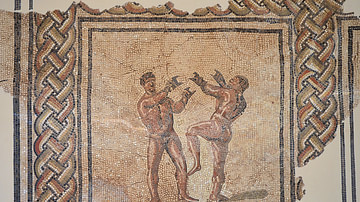Step back in time and explore the fascinating world of boxing during the Roman Empire. In this article, we will delve into the rich history and cultural significance of this ancient sport that captivated both athletes and spectators alike.
A Noble Tradition Rooted in Strength and Skill
Boxing, known as pugilatus in Latin, was a revered discipline that showcased not only physical prowess but also mental fortitude. It was considered an art form where combatants displayed their strength, agility, and strategic thinking within a confined space.
This noble tradition had its roots deeply embedded in Greek culture before being adopted by the Romans. The sport gained popularity throughout the empire due to its ability to entertain crowds while embodying values such as honor, discipline, and perseverance.
A boxer’s training regimen involved rigorous exercises aimed at enhancing speed, endurance, and technique. They would spend countless hours honing their skills through shadowboxing drills or sparring with fellow fighters under the watchful eye of experienced trainers.
An Arena for Spectacle: The Gladiatorial Games
One cannot discuss boxing without mentioning its prominent role within the grand spectacles of gladiatorial games held across various amphitheaters throughout Rome. These events attracted thousands of eager spectators who reveled in witnessing intense battles between skilled boxers.
The atmosphere within these arenas was electric as fans cheered on their favorite fighters with fervor. Boxers clad in leather gloves called caestus would engage each other with calculated strikes aiming for victory or even knockout blows if circumstances allowed it.
While some matches were fought purely for entertainment purposes using soft gloves or even bare fists to minimize injuries, others were more brutal affairs where participants risked life-threatening injuries amidst thunderous applause.
A Legacy Carved in Stone
The legacy of boxing within the Roman Empire can still be witnessed today through various archaeological discoveries. Ancient sculptures and reliefs depict boxers in action, frozen in time, capturing their strength and determination for eternity.
These artistic representations serve as a testament to the significance of boxing during this era. They provide us with glimpses into the past, allowing us to appreciate the skill and dedication required by these athletes who sought glory within the squared circle.
In Conclusion
Boxing held a special place within the cultural fabric of the Roman Empire. It was more than just a sport; it embodied values such as discipline, honor, and resilience that were highly regarded by both participants and spectators alike. Today, we can admire its enduring legacy through ancient artifacts that remind us of an era where physical prowess met artistry in one tranquil display of human achievement.

